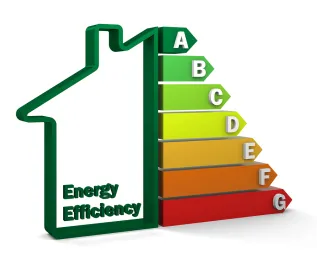SUMMARY
The government wants all non-domestic rented buildings to meet an EPC B by 2030 (currently the requirement is EPC E). It is consulting on how to implement this and to improve the compliance and enforcement process for EPCs. The change will affect one million properties.
WHAT IS AN EPC?
An EPC shows the energy efficiency levels of a property, so for example a prospective tenant can find out and compare the relative running costs of renting a property. The certificate will give each building a Standard Assessment Procedure (known as a SAP) and then there is a rating, which is graded from A to G (A is very efficient and G is very inefficient). The certificate contains information including, an estimation of the energy the property potentially uses, fuel costs i.e. an indication of how much it will cost to heat a property, details of savings that could be made if energy efficiency improvements are made, and CO2 emissions.
BACKGROUND
The Energy Efficiency (Private Rented Property) (England and Wales) Regulations set a minimum energy efficiency standard (MEES) of EPC E for private rented properties. The requirement that a property must be EPC E has applied since 1 April 2018 to properties let on new tenancies (including renewals), and from 1 April 2023 will apply to all privately rented properties (even where there has been no change in tenancy).
The government published a consultation in 2019 on how best to improve the energy performance of nondomestic private rented buildings through tighter MEES. The Government’s preferred option was for all non-domestic rented buildings to meet an EPC B by 2030. This has evidently received wide support and so the government is now consulting on the framework to implement this new requirement and improve the compliance and enforcement process.
The intention is that this will result in buildings that are cheaper to run, responsible for fewer carbon emissions and closer to being able to accept low-carbon heating systems.
The EPC B requirement will see the proportion of the non-domestic rented stock within scope of the Regulations increase from around 10 percent to around 85 percent. That is approximately one million buildings across England and Wales.
WHAT IS COVERED?
The consultation covers:
-
A phased implementation of the EPC B by 2030 requirement, with EPC C by 2027 set as an interim milestone
-
The introduction of two-year ‘compliance windows.’ The ‘compliance window’ will begin with the requirement for landlords to present a valid EPC and closes with the presentation of a valid EPC of the requisite rating. For EPC C, Government proposes the compliance window should be 2025-2027, and for EPC B 2028-2030.
-
A move away from enforcement at the point of let. Non-domestic EPCs will follow the proposed domestic changes, such as the requirement for non-domestic rental properties to continually have an EPC and the need to commission a post-improvement EPC to demonstrate compliance
-
A new Exemptions and Compliance database to provide the data that local authorities will require for enforcement and compliance monitoring
-
Updates to the penalty framework to enforce the new requirements
-
The ‘three quotes’ system for the seven-year payback will be replaced by a more efficient and user-friendly ‘payback calculator’
TIMING
The consultation closes on 9 June 2021. Draft regulations will then be drafted with a view to the changes coming into force in April 2025.
COMMENT
This government, and no doubt any replacing them in the future, have a green low carbon agenda. These changes are part of that agenda and represent a stick approach to the property industry which, seemingly, has been reluctant in the past to engage with the issue of the energy efficiency of their buildings. It is not clear whether there will be any carrots, as with say the U.S. where the availability of grants and incentives is widespread. The motivation for landlords to upgrade their buildings as a result of increasing demand from tenants seeking more efficient, greener buildings has only impacted prime properties until relatively recently but the changes made by these regulations will impact many secondary properties and force landlords to retrofit them unless they can come within the exemptions.
Although nine years may seem a long way off, landlords will need to act soon to be ready.
It is not immediately apparent how the phased implementation will help and the government themselves express the hope that landlords will carry out works to go straight to an EPC B rather than achieving an EPC C first.
With so many more properties brought within the scope of the regulations and with no doubt many more exemptions being sought, the cost of enforcement and monitoring compliance is likely to rise significantly. This will be borne by local authorities. No doubt they will want central government to help with funding.





 />i
/>i

